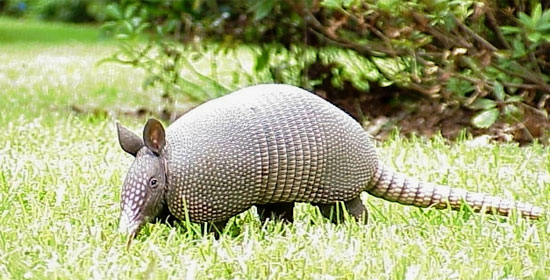Weekend Gardening: Outwit and Outlast Those Troublesome Armadillos
April 28, 2018
by UF/IFAS Extension Service
Have you ever discovered your once beautiful green lawn looking like the surface of the moon, full of craters? If so, then you may have been visited by an alien-looking creature known as the armadillo.
Armadillos originated in South America. They are mammals. They are neither rodents nor marsupials and are not related to the opossum. Their closest living relative is the anteater and sloth.
The most easily recognized feature of an armadillo is its shell. Their common name, armadillo, is derived from a Spanish term meaning “little armored one”. All armadillos have shells, made of true bone, that cover their backs. Most armadillos also have bony rings or plates that protect their tails.
Digging machines
Armadillos are built to dig. They rely on this ability to escape danger and survive. They prefer sandy or loam soils that are relatively easy to excavate. Therefore, they are well adapted to Northwest Florida soils.
Armadillos typically rest in deep burrows during the day and become more active during the late evening, night, or early morning. These burrows are usually located under brushpiles, stumps, dense brush, or concrete patios, and are about 7 to 8 inches in diameter and can be up to 15 feet long. They often have several burrows throughout their territory.
Food sources
Armadillos feed primarily on insects. They also eat earthworms, scorpions, spiders, snails, and small vertebrates and their eggs. They consume large amounts of armyworms, cockroaches, ants, wasps, flies, beetles, and grasshoppers. They have been known to dig up entire yellow-jacket nests.
Some consider the armadillo a beneficial creature because they eat potential pests. Many consider the armadillo a pest because of their destructive ways. Armadillo can burrow under driveways and patios causing structural damage. Burrows in pastures can pose a potential hazard to livestock. And because armadillos usually search for food by rooting or digging in the ground, they can damage large areas of the lawn or garden.
Control measures
If you find that you cannot live with these creatures, the University of Florida recommends four ways to deal with armadillos.
- reducing the amount of water and fertilizer you apply to your lawn
- creating barriers (e.g., fences),
- live-trapping
- shooting offending individuals (check local ordinances)
The best solution (and the most expensive) is a stout fence to keep the armadillos out. If you take this route, make sure the fence is buried at least 18 inches into the ground, or they might just burrow under it.
Reducing the water and fertilizer applications to your lawn may help reduce armadillo damage. A moist lush landscape is perfect for earthworms and insect larvae. Armadillos love earthworms. Sometimes watering adjacent areas may attract armadillos away from a site.
Trapping can be frustrating and may require some ingenious thinking. Some tried and true trapping techniques are discussed at length in an online University of Florida publication by Dr. Russ Mizell at http://ufinsect.ifas.ufl.edu/armadillo.htm.
Remember that poison baits are illegal and ineffective. No chemical repellents or fumigants are registered for use in Florida.
Armadillos are very happy in Northwest Florida and are here to stay. If they have become unwelcomed house guests, put your thinking cap on and be committed to outwitting and outlasting this prehistoric-looking creature.
Courtesy photos for NorthEscambia.com, click to enlarge.
Comments
7 Responses to “Weekend Gardening: Outwit and Outlast Those Troublesome Armadillos”





SIL had a big one on her property in the country. A Ruger .22 rifle with a SureFire flashlight mounted on it, and with a red dot sight on the gun, sent him to Armadillo heaven. High powered flashlight lit him up at night, and the red dot made it easy to line up the shot. These vermin will kill and eat new born kittens too. Take them out!
Bob C,
Thanks, I’ll keep it in mind.
David for microwaves
most of the time
@ David H Green
Granny used to call Armadillos, “Possum on the half-shell”.
Here’s a recipe for you from as reliable a source as NBC News but this isn’t Fake News: https://www.nbcnews.com/science/science-news/9-000-year-old-recipe-roast-armadillo-n24806
Robert…the 15 feet was in reference to the burrows they live in..”These burrows are usually located under brushpiles, stumps, dense brush, or concrete patios, and are about 7 to 8 inches in diameter and can be up to 15 feet long.”
Leprosy is treatable, so not the end of the world.
I think they’re cute, also tasty. Take your pick.
David for good eating
15 feet long, really?
They can also carry leprosy.
By Laura Clark
smithsonian.com
March 2, 2015
Last week, offficials in eastern Florida announced the emergence of three new cases of leprosy—the ancient, highly stigmatized disease once handled by isolation—in the last five months. And two of those cases have been linked to contact with the armored, strangely cute critter endemic to the American south: armadillos.
https://www.smithsonianmag.com/smart-news/how-armadillos-can-spread-leprosy-180954440/